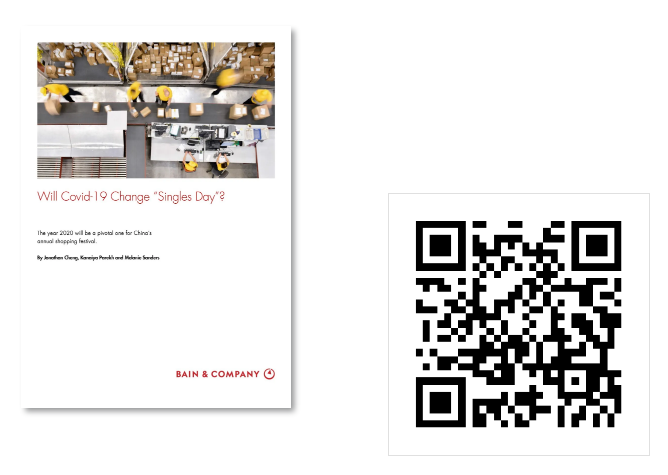* Click on the PDF button to get the full report
Singles Day 2020 is a pivotal test for China retailers and brand owners seeking to recover from 1H Covid impact
New research from Bain & Company finds 40 percent of consumers are planning to spend more in Double 11 this year but winning retailers will need to differentiate strategies for higher-tier and lower-tier cities
The year 2020 will be a crucial one for China's annual shopping festival Double 11 and the entire retail industry. The rest of the world is looking to the country for cues on how to recover from the impact of Covid-19 while China's foot traffic is still 20 percent lower than last year's levels.
Over the past five years, sales in the 24-hour period of Double 11 have grown by 35 percent annually, generating RMB 410 billion (approximately $60 billion) in gross merchandise value (GMV), double what Amazon generates in an entire month. But impacts of Covid-19 suggest an unclear road ahead for retailers' Singles Day sales growth in 2020 and beyond. Despite these challenges, there is optimism as over 40 percent of consumers state that they expect to spend more this year and the country is seeing significant growth from lower-tier cities. These are the conclusions of Bain & Company's latest report Will COVID-19 Change "Singles Day"?
Double 11 has advanced through three distinct stages since inception. After focusing first on driving Tier 1 and Tier 2 consumer online penetration through the sales event, Singles Day pivoted strategic intent to premiumization by trading consumers up to higher-priced goods. Last year marked the start of a new Double 11 chapter, polarization, where retailers experienced mounting competitive pressure and began to double down on lower-tier city event penetration while encouraging consumers in higher-tier cities to spend more.
Bain & Company Partner, Jonathan Cheng said that: Singles Day has been a consistent forward looking indicator of retail trends, as well as a guide to the heath and outlook of the market. The impact of Covid-19 puts greater pressure on the day to make up for retailers' lost sales in the first half of 2020. This year's event is the most important since the first Double 11 as retailers and brands have a dual focus on new penetration from lower-tier cities and increased share of wallet from existing higher-tier consumers. It will also shine a light on how China's digital leadership allowed the market to bounce back so effectively.
For the report, Bain conducted a survey with Chinese consumers to understand their intent going into this year's event. Results show that new user growth from lower-tier markets will remain strong, accounting for the majority of total DAU (Daily Active Users) growth. Additionally, while higher-tier markets start to hit the ceiling on saturation, lower-tier markets continue to grow online shopper penetration as a percentage of total web users, reaching roughly 54 percent in the first quarter of 2020, up from around 45 percent in 1H 2019.
Consumer electronics and Health and wellness products are two of the top categories that consumers have indicated are likely to be winners in this year's Double 11 event. As people shift to working and playing more from home, they are also transitioning to more time online – it was not surprising to see that 41% of those surveyed intend to increase spending on electronics. The pandemic has further accelerated a trend that had steadily been gaining momentum: consumer interest in health and wellness. As evidence, 42 percent of consumers expect to spend more on fresh food on Singles Day.
Jonathan Cheng said, "Covid-19 has accelerated many of the trends that we have been seeing for some time, and the winners in Double 11 this year will be the brands and retailers that have adapted to these changing consumer needs – eCommerce channels, local players, and value rather than premium offerings." "Online retailers and brand owners will need to make their propositions differentiated to be relevant for both lower-tier and higher-tier consumers while offline retail needs to learn lessons from Double 11 and adapt their strategy to attract footfall back in store."
For most retailers and brands, the aim will be to increase share of wallet in higher-tier markets and gain penetration in lower-tier markets, while managing brand and product portfolios accordingly. However, the ultimate long-term value of Double 11 as the most important 24 hours for China's retailers will depend on how successfully online platforms, offline retailers and brands rise to the occasion—this November 11 and in the 364 days that follow.




 微博
微博 微信
微信